Tools
Parts
-
-
Power off the Framework Laptop by navigating to the Windows icon on the bottom left and clicking on "Power" followed by "Shut down," or if on Linux, the equivalent action there.
-
-
-
Unplug your power cable from the USB-C Expansion Card in your Framework Laptop.
(I had formerly left a long comment here about how you guys 'forgot' to have a bit about removing the expansion cards...and while some official guide on this is probably a good idea to have, it's...not actually necessary to remove them! Even though in the build guide, they go in last, they don't actually need to come out in order to replace the screen! Heh.)
-
-
-
Close the lid on your Framework Laptop and place it upside down on a soft, non-marring surface, such as the bag that it shipped in.
-
Using the T5 bit in the Framework Screwdriver, unscrew the 5 fasteners on the Bottom Cover. These fasteners will remain attached in the Bottom Cover so that you do not lose them.
-
The fastener on the bottom left (circled in red) will not unscrew as far as the others, as it is acting as a lifter for the Input Cover.
-
You'll hear this fastener start clicking as you rotate when it is unscrewed far enough.
-
Do not use a powered tool for these steps, as this will likely result in damage to the fasteners.
It would be super nice if the lower-left screw were circled in red as the text indicates!
Mike Shaver - Resolved on Release Reply
Thank you for writing the specific detail on the lower left corner screw.
I thought something was not working correct until re-read this guide.
Patrick Corey - Resolved on Release Reply
-
-
-
Flip the Framework Laptop back over and open the lid to around 120 degrees.
-
Important: Pull the Input Cover off carefully as it is still attached to the Mainboard via the Touchpad Cable. You don't need to disconnect this cable to do most repairs. You can just flip the Input Cover over. If you do want to disconnect it though, make sure to disconnect the Mainboard side using the finger loop over the orange label.
-
The bottom right corner of the Input Cover lifts up when the five fasteners are properly unscrewed from the previous step. You should not have to use any excessive force to remove the Input Cover.
-
Carefully lift the cover up from the bottom right corner. If you need to, you can use the spudger end of the Framework Screwdriver to lift it as well. Lift the Input Cover off the Mainboard, flip it over (keyboard side down), and place it about halfway on the Bottom Cover.
-
Be sure not to put too much force on the Touchpad Cable when doing this.
-
If the LEDs on the left and right sides of the system are flashing red when you lift off the cover, it means the system is still powered on. Make sure your power cable isn't plugged in and that you have shut down correctly.
-
Note that it may take up to 30 seconds after shutting down for the system to fully power off. Wait until the LEDs stop flashing before proceeding.
-
You should keep the Battery connector plugged in unless you need to replace the Battery, Mainboard, or Speakers. This connector is easy to accidentally damage, so it's better to not handle it.
Important: Pull the Input Cover off carefully as it is still attached to the Mainboard via the Touchpad Cable. You don't need to disconnect this cable to do most repairs. You can just flip the Input Cover over. If you do want to disconnect it though, make sure to disconnect the Mainboard side using the finger loop over the orange label.
While that’s true for most repairs, it’s pretty much essential to disconnect that cable for this repair, so I think the guide should probably amend this boilerplate!
Mike Shaver - Resolved on Release Reply
You should flip the keyboard around the x-axis (so that the back edge comes towards you as you flip) and not the z-axis (resulting in the left edge rotating to the right). I started to do the z-axis and the touchpad cable was getting twisted. I am capable of messing up all instructions. This is my anti-super-power... or joker power in the Wild Cards universe.
-
-
-
If there is black shielding over the RAM slots, do NOT remove it. These are necessary to reduce interference with Wi-Fi.
-
Using your fingers, nudge the two metal clips away from one of the Memory modules just enough for the Memory module to pop up.
-
The module will rise up at a 20-degree angle.
-
Gently pull the Memory out of the socket.
-
Repeat this on the second Memory module if you have two installed and want to replace both.
Please add something about the thick plastic shielding covering the memory modules so people understand what they should look for/do. Otherwise install went fine
Chase Reed Denenberg - Resolved on Release Reply
Great review & video https://chromeunboxed.com/framework-lapt...
Steven Milstein - Resolved on Release Reply
-
-
-
Insert the Memory module into the Mainboard by aligning the notch on the Memory module with the notch on the socket.
-
Once the module is fully inserted, it will rise up at a 20-degree angle. Gently press it down towards the Mainboard until the clips located at the top and bottom of the receptacle snap into place (see the red arrows in the third image).
-
Note: If you are using one Memory module, place it in the right socket that is labelled “Channel 0."
-
Note: The first boot after installing a new Memory module will take longer than normal, as the system prepares itself for the new module.
There was a comment about the orientation of the memory cards being based on the sticker facing up or down. For anyone else also confused, as I was, don’t skip reading the first bullet, as I did. There is a notch on the memory card that is not symmetrical. It’s farther away from the screen. Line the cards with the notch. Don’t worry about any stickers. Also look closer at the picture, as I did not, there is an arrow pointing to the notch. It’s obvious when you see it, but we’re all dumb and impatient sometimes
Kevin Donoughe - Open Reply
The only part of this step that confused me was the orientation of the 2nd memory card. If there was some text or a picture showing the white print label needs to be facing down (towards the motherboard).
Patrick Corey - Resolved on Release Reply
1) Can memory modules of different capacities be installed together? Or do you need to use two modules of identical capacities?
2) When using two different capacity memory modules, should the higher capacity SODIMM be in the Channel 0 slot?
Craig Lewis - Resolved on Release Reply
-
-
-
Before closing up the laptop, make sure that the Touchpad end of the Touchpad Cable is fully seated in the receptacle.
-
The cable should be inserted far enough that the white line almost touches the receptacle.
-
If it is not inserted far enough, you'll need to flip up the black latch on the other side of the connector, slide the cable in further, and then close the black latch again.
-
-
-
Flip the Input Cover over the Bottom Cover so that the keyboard is facing up and attach it to the Bottom Cover by aligning the top and bottom edges of both covers.
-
Tip: The covers are magnetic and should fit into one another easily. If you feel any resistance simply lift the Input Cover up and try again.
-
-
-
Close the Framework Laptop and turn it upside down to reveal the five fasteners on the Bottom Cover.
-
Using the T5 bit in the Framework Screwdriver, screw all 5 fasteners back into the Bottom Cover.
-
Be sure to not over-tighten the fasteners.
-
Note that your first boot after installing new memory will take a while before the logo comes up on screen as the system does memory training. The more memory you've installed, the longer this could take (on the order of a minute or two with 64GB!)
-
- To purchase a Framework Laptop visit the Framework website
- Want to learn more about the Framework Laptop? Take a look at our blog
- If you have any questions or concerns, feel free to reach out to Framework Support
- To purchase a Framework Laptop visit the Framework website
- Want to learn more about the Framework Laptop? Take a look at our blog
- If you have any questions or concerns, feel free to reach out to Framework Support
Cancel: I did not complete this guide.
21 other people completed this guide.
8 Comments
There are two ram slots for the 13 inch amd laptop.
Can both slots be used for 16GB of DDR5 RAM?
And when you buy 2 sticks of 16GB of ram, are they supposed to be different to fit both?
I have two different ram keys on my 13 inch AMD and for some reason, only one of my DDR5 rams fits. The other doesn't... really strange
Good morning,
I'm in the same situation. I checked, my two RAM sticks fit correctly in channel 0. But not in channel 1. I tried by putting it in at a more or less different angle, more or less crooked. I'm still missing a millimeter to be able to put it in place. What did I miss?
alve -
Just to make sure:
Did you rotate the module which appears not to fit 180°, that way "aligning the notch on the Memory module with the notch on the socket."?
The non-symmetric notch separates the pins to prevent inserting the modules the wrong way.
Okay, this was almost too easy. It also shows that often times you get what you pay for in a very good way. After the first upgrade, to 96GB of PC5-5600 memory, I couldn't be happier with my choice of a Framework13. The whole insides are very first rate. It did take a couple of seconds to find the memory as there is a thin black plastic cover over the sticks that didn't appear in the instruction; however, it is right where it is shown in the instructions.
John Lindsey - Resolved on Release Reply
Please show me how the memory module cover plate is put back on (replaced) on a laptop.
Wendy Daniels - Resolved on Release Reply
What model of laptop are you talking about? The FrameWork doesn’t have a “memory module cover plate” to put back.
Forge -
This might be a good place to have a link to the list of compatible (tested) memory modules. Also might mention that sometimes you don’t get what you pay for, for example the more expensive Crucial Ballistix DDR4 3200 MHz SO-DIMM Gaming Laptop Memory modules which require that the computer provide 1.35 volts in order to achieve the 3200 MHz speed and with the Framework motherboard (1.2 volts) they run slower than 3200 MHz.


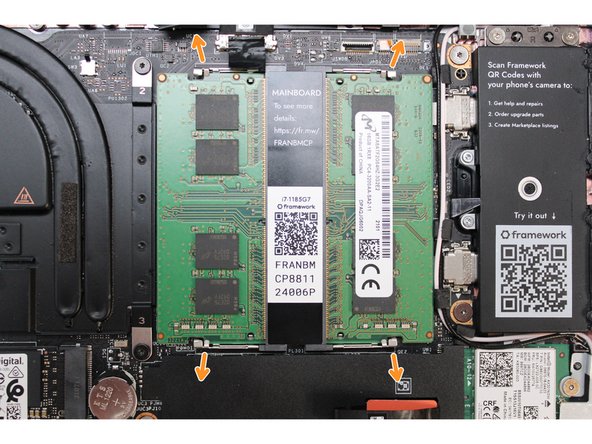

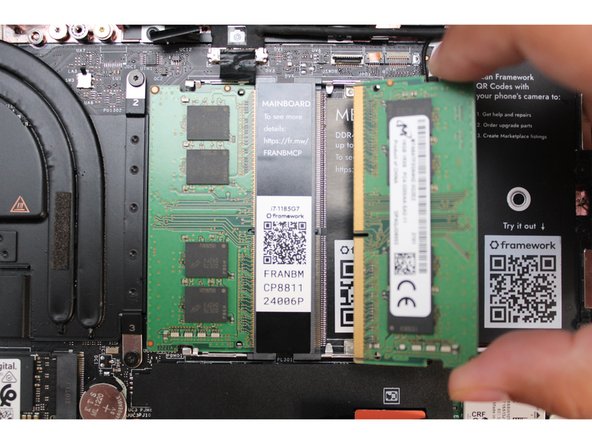
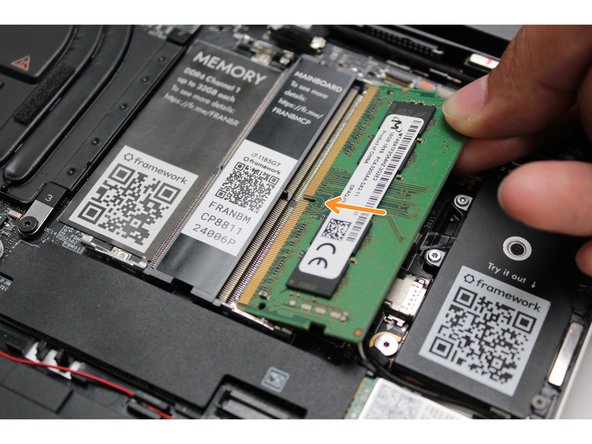
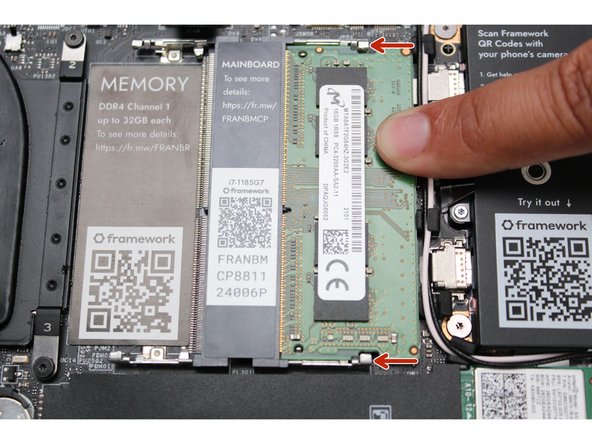
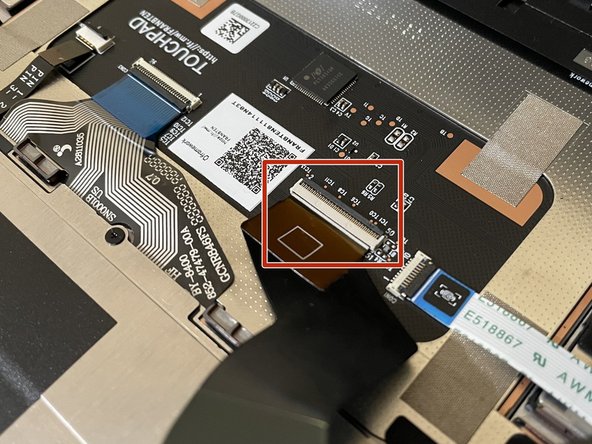


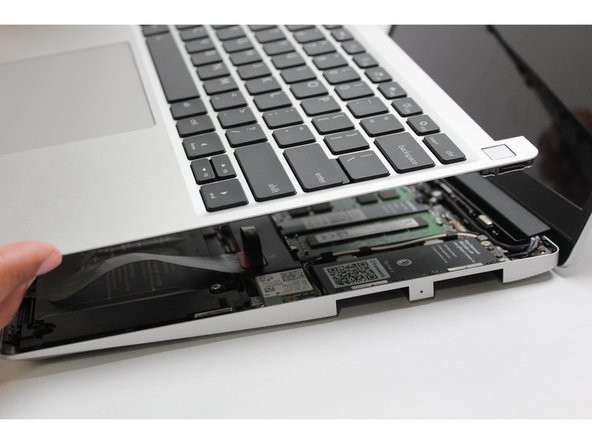



If you are upgrading to an Intel Ultra series, disable Bitlocker before shutting down your old main board if you are upgrading to an Intel Ultra series.
And for Ultra series, install windows as a fresh installation. This appears to be particularly important if you can't disable Bitlocker because your old main board died.
Jim Barron - Open Reply
Before even starting, inspect the new board to be sure all the connectors are ok. Mine had the speaker connector broken off.
Gary Aitken - Resolved on Release Reply
@ahappykittycat I wish that I had read your comment before I undertook this…
Mike Shaver - Resolved on Release Reply
IMPORTANT: If you plan to install your existing mainboard in a CoolerMaster case, make sure to boot into the BIOS and enable standalone mode before continuing.
Richard Tango-Lowy - Resolved on Release Reply
Pretty sure you might want to include a reminder to backup the bitlocker recovery key if it is enabled. The system will definitely boot to the bitlocker recovery screen since it will be a different TPM.
James Wu - Resolved on Release Reply
It could be helpful to give the bash terminal command to shutdown such as
Patrick Corey - Resolved on Release Reply
Bottom left*
Vijfhoek - Resolved on Release Reply